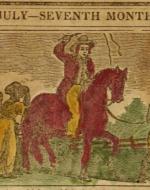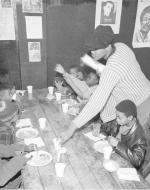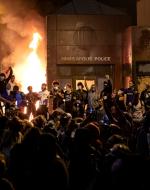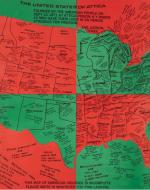Created by Elliott Samons on Wed, 04/17/2024 - 15:26
Description:
After the abolition of chattel slavery and the reversal of reconstruction, there was a shift in mechanisms through which slavery was legally maintained. In the United States for instance, as Black Codes were destroyed by the 14th amendment, Jim Crow laws continued to enforce racial disparities. This economic and legal disenfranchisement helped lay ground for sharecropping, a system of employment which kept people bound to work and live in unhealthy conditions through unpayable debts. Racism also has manifested in the form of discriminatory policing, providing an avenue for people to be enslaved through the 13th amendment, which outlawed chattel slavery, except for those convicted of a crime.
With reformations serving to change the shape of slavery rather than fully abolish it, abolitionist currents of action and thought have had to adapt to better navigate this new landscape of slavery and fully address the shortcomings of reformation. While abolitionist work and theory has persisted over generations, Matt Sandler’s article On Louise Gluck, Minstrelsy, and Abolition points to the “resurgence of abolitionism over the past decade, especially in this past summer’s (2020) massive protests of police violence.” Heightened awareness and rage pushed people into the streets and into a “range of collective emotions well beyond the reach of any one person’s imagination.” These collective emotions manifested in an equally wide range of actions which met different tenets of abolition, including blossoming networks of mutual aid and militant struggle.
This combination of creative and destructive collectivism evoked images of past abolitionist and revolutionary movements while expanding the lenses of our political imagination beyond the isolating limits of consumerism and electoralism. The images below are meant to depict similarities between historical and modern forms of slavery and abolition, connecting the horrors of slavery across history while painting the trajectory of abolition in a hopeful light.
Fig. 1 - https://www.ncpedia.org/slavery
This image from the American Antislavery Almanac published in 1838 shows an overseer on a horse. Behind the overseer’s horse are an enslaved woman and children who are watching as an enslaved man chained to the front of the horse is whipped by the overseer. The painting depicts the direct physical brutality of a beating while showing the psychological brutality bestowed upon those forced to watch. This trauma is depicted in Elizabeth Barret Browning’s The Runaway Slave at Pilgrim’s Point, where a woman who had escaped enslavement describes the treatment of the man she loved, “They wrung my cold hands out of his, / They dragged him—where? I crawled to touch / His blood's mark in the dust” (95-97). The positioning of the overseer between the enslaved man, woman and children could be interpreted as a reflection on family separation, a form of brutality that has carried into the modern prison slavery system. The plantation looming in the background shows the economic underpinnings of racism, highlighting that white people have accrued wealth by dehumanizing people of color for the sake of exploitation.
Fig. 2 - https://news.cgtn.com/news/2021-03-29/Slavery-is-alive-and-kicking-in-U-...
This still from the 2015 documentary “Angola for Life: Rehabilitation and Reform inside the Louisiana State Penitentiary” depicts a Correctional Officer riding his horse along a path next to imprisoned people as they work in a cotton field. The Angola prison farm resides on the same land as the former Angola plantation, one of the largest in the antebellum south at 18,000 acres. While indicative of the continuation of slavery, Angola also has a history of resistance and self-emancipation. As enslaved people escaped the plantation, they worked with Union gunboats and “challenged the traditional methods for maintaining slavery and helped to create a zone of emancipation along the banks of the Lower Mississippi River” (Cocanower 24). Angola Prison has since been a site of prison resistance and abolitionist education and action, with imprisoned people organizing for self-defense against racist guards and resources such as healthier living conditions and a library. Heiner points out that organizing like this can draw a bridge between reformist and abolitionist politics, arguing that “we must not allow our expansive vision to blind us to the immediate struggles of those locked down by the system” (Heiner 3). While white abolitionists such as William Blake and Elizabeth Barrett Browning treated death and spirituality as liberating forces, enslaved and imprisoned people have historically applied a wider range of philosophies and tactics to immediately improve their living conditions while advancing wider liberatory struggles.
Fig. 3 - https://foodfinders.org/2023/02/10/the-free-breakfast-movement-of-the-bl...
This is a photograph of a Black Panther’s Breakfast for Children Program event, a regular component of their “Survival Pending Revolution” program. The Panthers established community centers, education programs, and free health clinics, working across racial divides to meet the material and social needs of marginalized people. The programs served both as an antidote to the shortcomings of racial capitalism and as a method of political empowerment, developing necessary infrastructure outside the normal parameters of capitalist economics and electoral politics. While the Panthers were dissolved through COINTELPRO, imprisonment, and assassinations, their methods of community defense organizing have persisted today inside and outside the walls of prisons. Mutual aid programs have evolved to meet rising social issues, such as harm reduction programs to deal with the opioid epidemic or networks to distribute masks, tests, and groceries during the Covid-19 pandemic.
Fig. 4 - https://inthesetimes.com/article/2020-burning-third-precinct-minneapolis...
This image, taken on the third day of the George Floyd rebellion, shows a large crowd of people celebrating outside of the Minneapolis Police 3rd Precinct as it burns. After officers from the 3rd precinct murdered George Floyd, officers abandoned their position within the community and used the precinct building as a stronghold until they eventually ran out of less lethal ammo and fled. The building was then seized by the protesters and burned, an unprecedented response to the brutality of policing in the US. The burning precinct evoked images of burning plantations and shattered the illusion of the police as a force invulnerable to the consequences or contexts of history. The image of the burning station captured the collective joy and rage underlying militant protest, raising the potentials of abolition in the public consciousness. The proliferation of abolitionist ideas helped highlight the historical background of police, tracing the roots of modern policing back to city guards who patrolled slave quarters in the south or enforcers of the Fugitive Slave Act in the north. After the Watts riots, BPP cofounder Huey Newton wrote, “the property of the oppressor was destroyed to such an extent that no matter how the oppressor tried in his press to whitewash the activities of the black brothers, the real nature and cause of the activity was communicated to every black community.” While much of the energy from the George Floyd Rebellion was coopted and channeled into reformist language and politics, the message sent by the burnt precinct was clear. Many politicians who aligned themselves with the Black Lives Matter movement ended up increasing police funding and militarization, but the third precinct remains empty.
Fig. 5 - https://www.faithringgold.com/portfolio/united-states-of-attica/
I wanted to include this picture to honor artist Faith Ringgold, who passed away this past weekend. This painting, called the United States of Attica, was named for the Attica prison revolt which took place in September 1971. The uprising ended with state police killing 39 people at the demands of Gov. Nelson Rockefeller. The map highlights other instances of resistance, repression, and aggression within the United States, laying out a violent geography which allows events often viewed in isolation to be connected across time and space. By asking the viewer to “Please write in whatever you find lacking,” Ringgold invites us to engage critically with this history.
Citations:
Browning, Elizabeth Barrett. 'The Runaway Slave at Pilgrim’s Point'. Published 1848, in The Liberty Bell.
Cocanower, Evan, and Robert Gudmestad. "Self-Emancipation along the Lower Mississippi River in 1863." Journal of Slavery and Data Preservation 5, no. 1 (2024): 22-27. https://doi.org/10.25971/2ac1-6c95
Heiner, Brady Thomas. “Commentary: Social Death and the Relationship between Abolition and Reform.” Social Justice, vol. 30, no. 2, June 2003, p. 98.
Newton, Huey P. “the Correct Handling of a Revolution.” Verso, 15 Oct. 2016, www.versobooks.com/blogs/news/2865-the-correct-handling-of-a-revolution-....
Sandler, Matt. “On Louise Glück, Minstrelsy, and Abolition.” Verso, 13 Jan. 2021, www.versobooks.com/blogs/news/4963-on-louise-gluck-minstrelsy-and-abolition.






